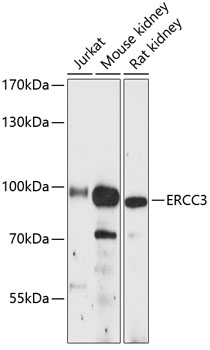-
Product Name
ERCC3 Polyclonal Antibody
- Documents
-
Description
Polyclonal antibody to ERCC3
-
Tested applications
WB
-
Species reactivity
Human, Mouse, Rat
-
Alternative names
ERCC3 antibody; BTF2 antibody; GTF2H antibody; RAD25 antibody; TFIIH antibody; TTD2 antibody; XPB antibody; ERCC excision repair 3, TFIIH core complex helicase subunit antibody
-
Isotype
Rabbit IgG
-
Preparation
Antigen: Recombinant fusion protein containing a sequence corresponding to amino acids 512-782 of human ERCC3 (NP_000113.1).
-
Clonality
Polyclonal
-
Formulation
PBS with 0.02% sodium azide, 50% glycerol, pH7.3.
-
Storage instructions
Store at -20℃. Avoid freeze / thaw cycles.
-
Applications
WB 1:500 - 1:2000
-
Validations

Western blot - ERCC3 Polyclonal Antibody
Western blot analysis of extracts of various cell lines, using ERCC3 antibody at 1:3000 dilution.Secondary antibody: HRP Goat Anti-Rabbit IgG (H+L) at 1:10000 dilution.Lysates/proteins: 25ug per lane.Blocking buffer: 3% nonfat dry milk in TBST.Detection: ECL Enhanced Kit .Exposure time: 90s.
-
Background
ATP-dependent 3'-5' DNA helicase, component of the general transcription and DNA repair factor IIH (TFIIH) core complex, which is involved in general and transcription-coupled nucleotide excision repair (NER) of damaged DNA and, when complexed to CAK, in RNA transcription by RNA polymerase II. In NER, TFIIH acts by opening DNA around the lesion to allow the excision of the damaged oligonucleotide and its replacement by a new DNA fragment. The ATPase activity of XPB/ERCC3, but not its helicase activity, is required for DNA opening. In transcription, TFIIH has an essential role in transcription initiation. When the pre-initiation complex (PIC) has been established, TFIIH is required for promoter opening and promoter escape. The ATP-dependent helicase activity of XPB/ERCC3 is required for promoter opening and promoter escape. Phosphorylation of the C-terminal tail (CTD) of the largest subunit of RNA polymerase II by the kinase module CAK controls the initiation of transcription.
Related Products / Services
Please note: All products are "FOR RESEARCH USE ONLY AND ARE NOT INTENDED FOR DIAGNOSTIC OR THERAPEUTIC USE"
